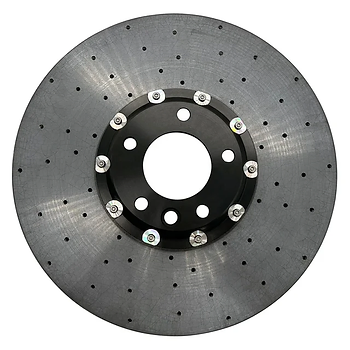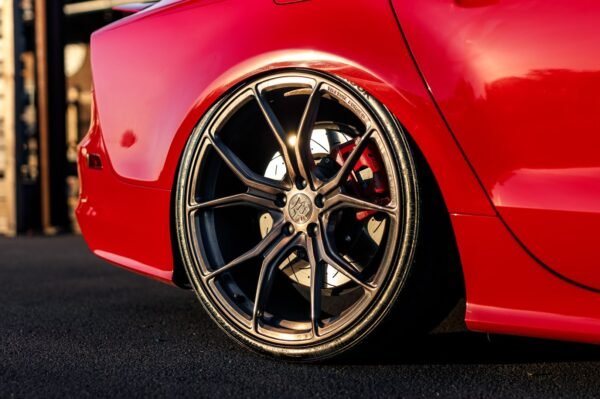Imagine you’re behind the wheel of a high-performance car, racing down the open highway. Suddenly, an obstacle appears and you need to stop – fast. The difference between a close call and disaster could well depend on the type of brakes in your vehicle. This is where carbon ceramic brakes and carbon composite brakes come into play.
Welcome to the world of advanced braking technology – a realm where every millisecond counts, where precise control meets unyielding performance under pressure. In this article, we will delve into these two cutting-edge brake technologies, dissect their pros and cons, and help you understand which one would best suit your needs.
Overview of Carbon Ceramic Brakes

Carbon Ceramic Brakes, often known as Carbon-Ceramic Matrix (CCM) brakes, are an astounding fusion of technology and function that represents a new frontier in automotive performance. Unlike traditional steel brakes, these high-tech marvels are forged from a composite blend of carbon fiber and silicon carbide. This synergy results in stronger, lighter brake assemblies providing superior stopping power with extraordinary resilience under high-performance conditions.
What sets Carbon Ceramic Brakes apart is their outstanding longevity coupled with immense heat dissipation capacities. The silicon carbide component acts as a potent heat sink, swiftly carrying away the extreme temperatures generated during heavy braking situations. Coupled with the fact that they’re about half the weight of standard brakes thus reducing unsprung mass – it’s no wonder why carbon ceramic systems have become synonymous with high-performance vehicles! Undeniably, this brake cog brings more than just stopping force; it delivers technical superiority for heightened driving experiences.
Benefits of Carbon Ceramic Brakes
Unquestionably, carbon ceramic brakes have revolutionized the braking systems in both motorsport and high-performance vehicles. A notable benefit of these wonder-brakes is their remarkable lightness. With weight being every racer’s nemesis, the lightweight feature equates to higher speed potential and better fuel economy for everyday drivers.
But what truly sets carbon ceramic brakes apart is their astonishing durability combined with superior performance. Not only do they resist wear-and-tear much longer than conventional steel brakes — reportedly up to 80,000 miles without needing replacement — this extraordinary endurance doesn’t compromise on efficiency or power. Indeed, whether under extreme heat conditions in intense racing environments or during everyday driving, these brakes deliver consistent high-level performance with minimal brake fade. This combination of long life and reliable excellence offers exceptional value for car enthusiasts who never compromise on safety.
Overview of Carbon-Carbon Composite Brakes
Carbon-carbon composite brakes are a type of high-performance braking system that utilizes carbon fibers in both the reinforcement and matrix phases. Unlike carbon ceramic brakes, where the matrix material is typically a ceramic like silicon carbide, carbon-carbon brakes consist entirely of carbon-based materials. This type of brake system is known for its exceptional strength, high-temperature resistance, and lightweight characteristics.
The manufacturing process for carbon-carbon composite brakes involves several steps, including the creation of carbon-carbon composite sheets. This typically includes impregnating carbon fibers with a carbon-rich resin (pitch or phenolic resin), followed by a curing process at high temperatures. The cured composite sheets are then stacked and densified through additional heating processes.
The stacked and cured composite sheets undergo a carbonization process, where the resin is pyrolyzed, leaving behind a structure composed almost entirely of carbon. This process enhances the material’s heat resistance and strength. To further improve the material’s properties, the carbon-carbon composite undergoes densification, where it is subjected to high temperatures and pressures in an inert atmosphere. This step increases the density of the material, improving its mechanical and thermal performance.
After the composite material is prepared, it is machined to the required shape and specifications for use in brake discs. Precision machining is crucial to achieve the desired braking surface, dimensions, and performance characteristics.
Benefits of Carbon-Carbon Composite Brakes
Impressively, Carbon-Carbon Composite Brakes (CCC brakes) redefine the braking experience in motorsports and aeronautics, by providing exceptional thermal stability. More than any other type of brake, CCC brakes seamlessly perform even under extremely high temperatures, up to 3000 degrees Celsius. A feat impossible for traditional metal-based brakes which falter at around 700-800 degrees. This makes CCC brakes ideal for applications subjected to intense heat such as in racing cars and aircraft.
Beyond temperature resistance, these power-packed paraphernalia also exhibit impressive wear resistance ensuring longevity. Unlike their metallic counterparts that display significant wear and tear with repeated use, CCC brakes showcase minimal degradation over time due to their unique structure. Additionally, the weight savings- another sterling advantage of carbon-carbon composites cannot be overlooked. With almost half the weight of conventional braking systems but same strength or more; they offer potential layout flexibility and reduction in fuel consumption particularly invaluable in aerospace applications!
Comparative Analysis: Carbon-Ceramic vs. Carbon-Carbon Composite Brakes
Carbon ceramic brakes utilize a ceramic matrix, often silicon carbide, combined with carbon fibers, providing a balanced mix of lightweight design, improved thermal stability, and durability in high-performance automotive applications. On the other hand, carbon-carbon composite brakes employ an all-carbon construction, with both the matrix and fibers composed of carbon. Known for exceptional strength, high thermal conductivity, and resistance to extreme temperatures, carbon-carbon composite brakes find applications in aerospace and racing realms, where stringent demands for superior thermal and structural performance are critical. While both types offer weight reduction benefits and efficient heat dissipation, carbon ceramic brakes are favored in the automotive sector, whereas carbon-carbon composite brakes are prominent in aerospace and racing applications, with each system having its unique advantages and manufacturing complexities.


